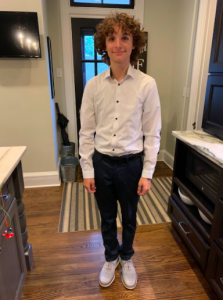Keratoconus Journey: Louis

As a young high school student, life can bring many challenges – whether it be schoolwork, sports, or friendships. While most teens are navigating through their adolescence and growing pains, others – like Louis – are discovering they are also living with a progressive eye condition.
Unexpected Challenges
When Louis was 15 years old and a freshman in high school, he visited the school nurse for a vision screening test that was required for students. To Louis’s surprise, he failed the exam and was referred to Optometrist Dr. Emily Shull at SIGHT Eyewear and Eyecare by his school nurse for further testing. During his visit with Dr. Shull, Louis assumed he would be prescribed glasses or contacts. Instead, Louis was told he was living with keratoconus, a progressive eye condition.
Abby, Louis’s mom, was not expecting that her son’s first eye exam would lead to him being diagnosed with a progressive eye condition. Dr. Shull explained that there were various treatment options, including cross-linking, contact lenses, or a corneal transplant. By the end of the appointment, Abby and Louis were leaving with a referral to ophthalmologist Dr. Adam Kaufman at the Cincinnati Eye Institute, to learn more about the condition and available treatment options.
A Shocking Realization
Louis has always considered himself an active teen. He played baseball, ran cross country, was a lifeguard, and enjoys archery and shooting guns. Unfortunately, he stopped playing baseball because it was difficult for him to see the ball and lifeguarding became a struggle as he sometimes could not see how deep the swimmers were. With the recommendation to visit Dr. Kaufman, Louis was hopeful that he would finally get some answers about his vision, learn more about his diagnosis, and hopefully return to some of the activities that he loved.

During the appointment with Dr. Kaufman, Louis was shocked to learn that he was almost blind in his right eye. When discussing some of the previous vision issues he experienced, Dr. Kaufman discovered Louis had been overcompensating in his left eye, not realizing how poor his vision had become in his right. Dr. Kaufman recommended the iLink® FDA-approved cross-linking procedure for Louis’s progressive keratoconus, which is meant to slow or halt the progression of the disease. Following the procedure, Louis would then be able to be fitted with contact lenses with the goal of improving his vision[1][2]. Abby was a little hesitant at first because she had never heard of keratoconus and wondered what the best option would be for her 15-year-old son. She asked questions during the appointment and began doing her own research at home to make sure her son would get the treatment that was right for him.
After learning more about the iLink® procedure and that it was a minimally invasive procedure, and intending to keep his condition from worsening, Louis and Abby decided this treatment was right for him. Louis was diagnosed with progressive keratoconus in March 2021, and they quickly scheduled an appointment for September, he was scheduled to have his right eye treated with iLink® at the Cleveland Eye Institute. Louis was a little nervous about being awake during the procedure but knew that cross-linking was the right decision for his long-term eye health.

Navigating After Treatment
Following Louis’s iLink® procedure in his right eye, he began using drops to help with inflammation. Louis has yet to be prescribed lenses but he plans to get a gas permeable contact for his right eye, once he has reached 3 months post-procedure. During the initial follow-up appointment, Dr. Kaufman predicted that Louis’s vision will likely improve after he receives his contact[1][2]. He is also monitoring Louis’s left eye to determine if it progresses. All three are pleased to see the results of Louis’s procedure, bringing some much-needed relief to Abby and Louis. Now, Louis is looking forward to the future and potentially trying baseball out again!
As for his mom, Abby, she is extremely grateful that her son was diagnosed and treated early. She is especially thankful for the school nurse that identified Louis’s vision issues and was proactive in referring him to Dr. Shull and the eventual recommendation to Dr. Kaufman. Abby was also shocked to learn that to help ease any worries, the Cleveland Eye Institute would allow her to watch the procedure happen in a room nearby – which comforted her knowing that Louis was in safe hands. She is now confident that iLink® was the right choice for her son and recommends that parents seriously consider iLink® FDA-approved cross-linking if their child is diagnosed with progressive keratoconus and eligible for the procedure.
[1] Kreps, E. O., Pesudovs, K., Claerhout, I., & Koppen, C. (2021). Mini-Scleral Lenses Improve Vision-Related Quality of Life in Keratoconus. Cornea, 40(7), 859–864.
[2] Baudin, F., Chemaly, et al. (2021). Quality-of-Life Improvement After Scleral Lens Fitting in Patients With Keratoconus. Eye & contact lens, 47(9), 520–525.
Find a Cornea Cross-Linking Specialist Near You:
The results described on this site are based on data collected regarding short- and intermediate-term efficacy of treatment. Individual results are not guaranteed and may vary.